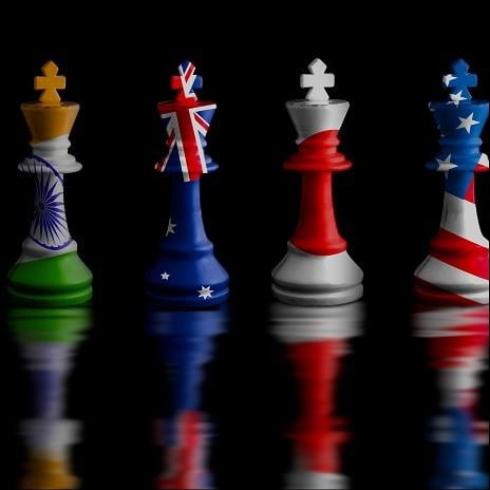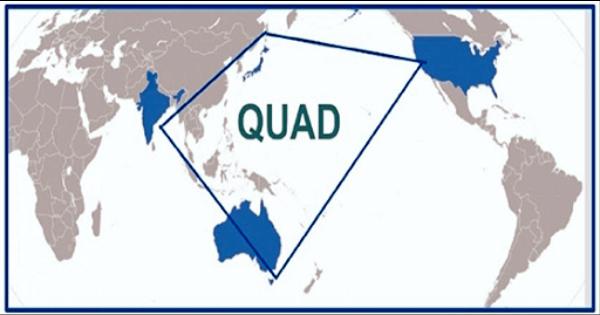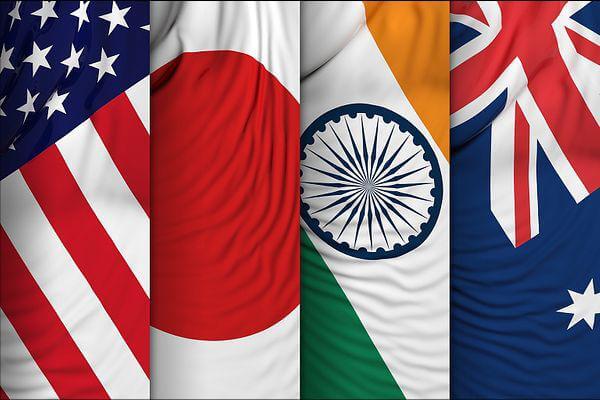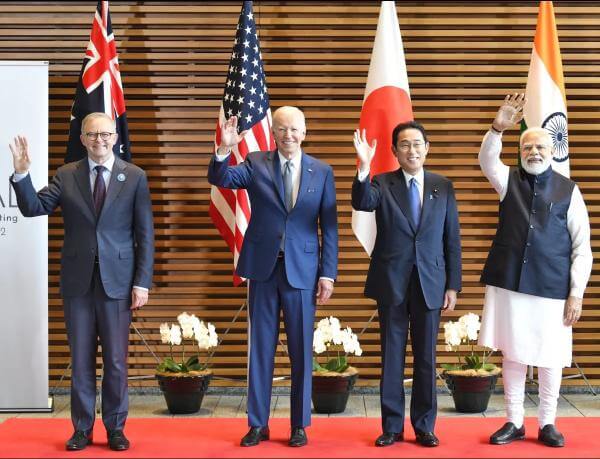What is the Full Form of QUAD
QUAD: Quadrilateral Security Dialogue (QSD)
QUAD is commonly known as the 'Quadrilateral Security Dialogue (QSD). It is a kind of strategized security forum that involves four countries in it, namely- India, the United States of America (USA), Australia, and Japan. This security dialogue is maintained by semi-regular summits, meetings, information exchanges, military drills, and discussions between the member countries of this forum. The main motto behind the formation of the forum and its ultimate aim is to work hard to achieve a peaceful, free, prosperous, and inclusive environment in the Indo-Pacific region.

This dialogue was initiated in the year 2007, and their first meeting happened in the same year n the sidelines of the Association of South East Asian Nations. It was the Prime Minister of Japan, Shinzo Abe, who took the initiative for the formation of this group, and he was supported by the leaders of the other three countries, such as the Australian Prime Minister John Howard, U.S. Vice President Dick Cheney and Narendra Modi, the Prime Minister Of India.
Exercise Malabar, a series of combined military drills that never happened, took place in parallel with the dialogue. All the military and diplomatic arrangements were seen as a response to the developing economic and military power of China. The Chinese government officials criticized the mentions and talks of the Quadrilateral and nicknamed them "Asian NATO". In response, S. Jaishankar, the foreign minister of India, denied China's strong declarations and made it clear a crystal that India never had a "NATO mentality."
Key Details
- Shinzo Abe, the Former Prime Minister of the United States, had an idea in his mind about the establishment of an "Asian Arc of Democracy" by the Quadrilateral.
- As we know that the abbreviation for the Quadrilateral Security Dialogue is QUAD. Also, the group was first formed in 2007, and all four countries worked in sync until 2008.
- It was in November 2017, the dialogue was re-established after undergoing the required negotiations in November.
- This Inter-governmental security forum was spread in the Indo-Pacific region of the earth with four major states working together, namely- India, Australia, Japan, and the United States of America.
- Three countries are the Quad Plus additional members: South Korea, Vietnam, and New Zealand.
During Kevin Rudd's time as prime minister, the Quad came to an end as Australia withdrew, reflecting Australian policy ambiguity towards the rising tension between the United States and China in the Asia-Pacific. After Julia Gillard succeeded Rudd as prime minister in 2010, increased military cooperation between the two countries resumed. As a result, U.S. Marines were stationed close to Darwin, Australia, with a view of the Timor Sea and Lombok Strait. Malabar continued to host joint naval exercises between India, Japan, and the US.

When the ASEAN Summits in Manila were going on the year 2017, all four members countries led by Abe, Indian Prime Minister Narendra Modi, Australian Prime Minister Malcolm Turnbull, and the US President Donald Trump nodded in agreement towards the suggestion of reviving the Quadrilateral alliance so that they can counter China both in the military and diplomatic manner in the Indo-Pacific region of the earth, specifically in the South China Sea part of the Indo-Pacific. The kind of tension that is sensed between the four member countries and China is often believed to lead to fears and is referred to as a new cold war by some of the commentators.
In a joint statement titled "The Spirit of the Quad" that was stated in March 2021, the Quad countries outlined their aim towards having a Free and Open Indo-Pacific and a "rules-based maritime order in the East and South China seas.". The Quad members claim that these are necessary to counter Chinese maritime claims. South Korea, New Zealand, and Vietnam were represented at the first Quad Plus meeting, which was brought together as part of the Quad's commitment to react to COVID-19.
Creation and Cessation of the QUAD
Creation
- At the start of the year 2007, Former Prime Minister Shinzo Abe brought a proposal for the Quadrilateral Security Dialogue in front of the people, and under this initiative, India shook hands with the United States, Japan, and Australia and collectively joined a formal multilateral dialogue.
The credit for the initiation of a defense arrangement that was followed by the four countries, based on the idea of Democratic Peace, went to Shinzo Abe, the former Prime Minister of Japan. The dialogue was believed to form an "Asian Arc of Democracy" and was supposed to add more countries under this dialogue in the future, such as the states in Central Asia, the Korean Peninsula, and so on. It was supposed to involve "virtually most of the countries in on the periphery of China, except for China itself."

- This planning which involved most of the Asian countries and others leaving China outside led some critics to claim the dialogue as a type of "anti-Chinese move", while others have referred to it as a "democratic challenge" to the expected Chinese century, mounted by Asian powers in collaboration with those of the United States. While the Quadrilateral was seen as an "Asian NATO," China has historically preferred the Shanghai Cooperation Organization. According to Daniel Twining of the German Marshall Fund of the United States, depending on whether China emerges as Asia's democratic leader, the agreement "may lead to military war" or "create a durable foundation for peace."
China's Opposition
- In defense of this quadrilateral dialogue, China started diplomatic protests against all the members of the dialogue before presenting any kind of traditional meeting in front of the members. A month after combined naval drills by India, Japan, and the United States near Tokyo, Australian Prime Minister John Howard attended the Quadrilateral's first meeting in May 2007 in Manila along with other countries because of Cheney's insistence.
- Additional naval drills, including those involving Australia, were conducted in the Bay of Bengal in September 2007. These were followed by a further security pact between Japan and India in October, which was confirmed during an official visit by Former Prime Minister of India, Manmohan Singh, to Tokyo. Previously, Japan had only established such a pact with Australia, and India was the second country to sign that make.
- Even though the initiative of forming a Quadrilateral by the Bush administration helped in improving its relationship with New Delhi, it started serving as a plan of encircling China. The security agreement that was signed between India and Japan made China more unsettling because of the absence of China's name on the list of strategic partners of Japan in Asia. All these incidents led to the idea that China was being alienated along with the ASEAN, and Washington-centric alliances were being spread in Asia.
- Taro Aso, the present Prime Minister of Japan succeeding Abe, lessened the importance of China in the Japan-India pact signed after the formation of the Quadrilateral and it said, "China was merely mentioned - and we are not looking forward for a third country such as China as a target." Likewise, the Indian Foreign Minister Shiv Shankar Menon, without specifically pointing to China in the conversation, argued that the reason behind the overdue defense agreement was the Indian freight trade with Japan.
- Manmohan Singh, the Indian Prime Minister, met with President Hu Jintao and Prime Minister Wen Jiabao in January 2008 as he prepared to travel to China. During that period, when he was asked about the Quadrilateral, he clarified all the queries that "India is not part of any so-called contain China effort,".
Australia's Departure During Rudd
- According to the 2007 Canberra Defence Blueprint, Australia's desire for a defense deal with the United States was influenced by concerns over Chinese military spending and missile capabilities. Being motivated by Sandy Gordon's advice from the Australian Strategic Policy Institute since similar factors were taken into account while selling uranium to India, as it seemed like the United States was supporting it as a "counter to growing China" however, even before the agreements were started, Australia started feeling uneasy due to Chinese anger over the Quadrilateral.
- Kevin Rudd, after becoming Prime Minister, had a meeting with the Chinese foreign minister, Yang Jiechi, even before he visited Japan, and in due course, he organized a meeting between the foreign ministers of both nations, that is, Yang of China and Stephen Smith of Australia, which resulted in the unilateral announcement by Australia, that, it would "not be proposing" a second round of dialogue between the four partners.
- Among the Australian people, it was trending that the decision was motivated by the uncertainty of China-United States relations and the question arose that China, which is the principal economic partner of Australia, does not have a role as the strategic partner of Australia. Although among all this, Rudd feared the regional escalations in conflict and attempted to diffuse these via an "Asia-Pacific Union."
- When US President Obama put some efforts to improve US- India rations in November 2009, then both India and Australia got alarmed by the possibility that any step towards deepening the military alliance between these countries could lead to problems in Asian regions. The reason behind the ongoing tension between India and China was due to the dispute between the Indian province, that is, Arunachal Pradesh, and also the stationing of China's nuclear weapons on the Tibetan Plateau.
2017 ASEAN Summit
- Japan invited the countries who were the previous members of the Quadrilateral, that is, India, the US, and Australia, in August 2017 to conduct a joint meeting for foreign ministers at the time of the ASEAN summit that was held in November.
- At that time, Prime minister Abe and Donald Trump had a meeting and decided to take the road of "A Free and Open Indo-Pacific" strategy, a concept which originated in the US by the Secretary of State, Hillary Clinton. This decision was seen as a response to the Belt and Road Initiative taken by China at that time.
- The meeting between the member countries of the Quadrilateral was held five times from 2017 to 2019. When the Raisina Dialogue was held in New Delhi in the year 2018, all four member countries came together, which indicated the revival of the Quadrilateral and its security structures.

- In the year 2019, four ministers had a meeting in New York City to propose the reformation of the QUAD. They met in Bangkok as well for the same. During the time of the summer next year, Japan, India, mad the US have invitations to Australia to the coordinated navy exercise that was going to be held in Malabar but got delayed due to the COVID-19 situation.
- On May 24, 2022, Indian Prime Minister Narendra Modi, in his opening remarks, stated that the Quad has acquired a key position on the international stage and is a "force for good" for the Indo-Pacific region.
Conclusion
The four Quad members have significantly contributed to reframing the "Asia-Pacific" as the "Indo-Pacific" to develop transregional relations between the Indian and Pacific Ocean regions and, in their words, deal more efficiently with the rise of China, the Middle East, and Africa.
|


 For Videos Join Our Youtube Channel: Join Now
For Videos Join Our Youtube Channel: Join Now












